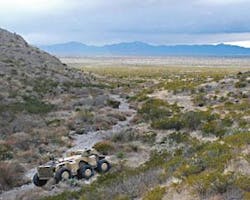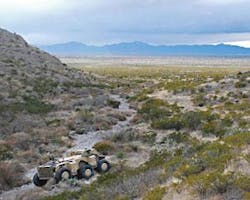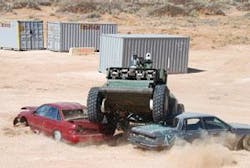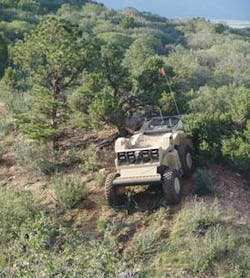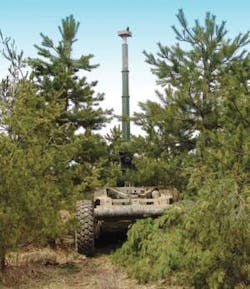And in this corner… The Crusher!
By Courtney E. Howard
Today’s unmanned ground vehicles (UGVs) are outfitted with the latest technology, making them smart, tough, and well armed.
UGVs are increasingly relied on for myriad tasks, not the least of which are bomb disposal, surveillance and reconnaissance, and chemical and biological agent detection. For this reason, the U.S. Department of Defense (DOD) as well as organizations and technology companies serving the military market continue to invest heavily in the research and development of advanced unmanned platforms.
In fact more than $24 billion of the $230 billion earmarked for U.S. Army’s Future Combat Systems (FCS) program will be spent on unmanned systems. Significant attention is paid to unmanned aerial vehicles, with their often awe-inspiring air shows; yet, at the same time, much is happening to advance unmanned ground combat vehicles (UGCVs).
It is perhaps no coincidence that the Crusher, the Army’s latest UGV boasts a moniker befitting a contender in a monster truck rally. The Crusher is a worthy adversary, one capable of scaling rough terrain, and even other vehicles. Crusher is the result of four years of work by engineers at the Defense Advanced Research Projects Agency (DARPA), U.S. Army, and Carnegie Mellon University’s National Robotics Engineering Center (NREC) in Pittsburgh, Pa.
Crusher is an upgraded version of the Spinner UGV, previously developed by DARPA and the Army, and part of a roughly $35 million, DARPA-led effort to make robots more autonomous.
Crusher is a major improvement in unmanned ground vehicle capability, according to Larry Jackel, DARPA UPI program manager. “The original Spinner UGCV is an excellent platform, but in shakeout experiments, the new Crusher has already outperformed Spinner in all aspects.”
The DARPA Tactical Technology Office (TTO) Unmanned Ground Combat Vehicle (UGCV) – Perception for Off-Road Robotics (PerceptOR) Integration (UPI) program responsible for the Crusher is designed to yield a UGV that operates reliably in obstacle-rich terrain. The TTO UPI team aim to accomplish this goal through a combination of autonomous navigation algorithms, best-in-class sensors, and electronic terrain data within the UGV platform. A joint program between DARPA and the Office of the Assistant Secretary of the Army for Acquisition, Logistics, and Technology, UPI is managed by the DARPA TTO in Arlington, Va.
The Army’s Program Manager Future Combat System, Brigade Combat Team closely follows the UPI program, the technologies of which will transfer to the FCS UGV Integrated Product Team for use in System Development and Demonstration efforts and FCS early spirals in fiscal year 2008.
Crusher is a six-wheel-drive, hybrid electric UGV constructed of aluminum and titanium that weighs in at 14,000 pounds fully fueled. Able to carry as much as 8,000 pounds of payload and armor, Crusher is powered by in-hub electric motors, lithium-ion batteries with high power density, and an industrial-grade Volkswagen Jetta 60-horsepower, turbo diesel engine. Crusher is also outfitted with a Rafael Mini-Typhoon gun mount that holds a .50-caliber rifle.
This past February, the Crusher completed toughness, mobility, and autonomy testing under Army soldier guidance at Fort Bliss, Texas. The six-wheeled vehicle with 49-inch tires traversed a 26-mile stretch of rough desert terrain that included slopes and gullies with up to a 40-degree grade, steep piles of rock up to roughly four feet in height, tank tracks, vegetation, and other obstacles. Crusher has executed various missions, including defining main and alternate supply routes, determining and clearing locations to establish forward operating bases, performing route reconnaissance, and maneuvering between checkpoints and observation posts not only on-road, but also off-road in dunes, off-road in washes, off-road at the edges of mountains clearing caves, and in urban environments.
Crusher used a series of laser radars, sensors, and cameras on an 18-foot, telescoping mast to gather terrain data, which was relayed to high-performance computers that guided the UGV’s movements. In fact, all Crusher functions—mission planning, perception monitoring, vehicle monitoring, and payload operation—merge in the operator workstation interface.
Thanks to engineers from the Robotics Institute at Carnegie Mellon, including robotics expert and NREC director John Bares, the self-piloted Crusher learns from what it runs over, runs into, and encounters. It uses a three-pronged approach to autonomy—digital maps, sensors, and cameras—to “read” the terrain, and distinguish flat ground from vegetation and other impediments and obstacles. During the demonstration in February, Crusher scanned the area for an easier spot to cross when it encountered an obstacle, such as a very steep ledge, and even turned itself around to continue along the assigned course.
Laser rangefinders, four on the front and one on the back, fire out invisible lasers to measure the distance between the UGV and the terrain roughly 20 to 30 meters around it. Another advanced laser rangefinder positioned at the top of the Crusher can scan the terrain at distances of 60 to 70 feet. Several front and rear cameras, which can be used in stereo, evaluate the terrain and determine the material composition of objects up to 70 meters from the UGV.
“These devices tell us the shape of the terrain, and that is very important for identifying different types of hazards such as dropoffs, steep slopes, and ditches,” says Tony Stentz, a Carnegie Mellon robotics engineer working on Crusher’s autonomy. Currently, certain hazards are difficult for Crusher to detect. “A ditch that has vegetation growing over the top of it or a rock inside very tall grass provide obstacles that on-board sensors cannot detect,” he continues. Work continues in this regard, and to improve communication between the UGV and remote soldiers’ computing platforms, including handheld devices.
With the right mix of communication software, says a UPI team member, Crusher could be controlled from anywhere using any of a variety of devices, including an Apple iPod Touch music player. Crusher’s systems and payload can be controlled remotely, but Army soldiers testing the UGV find it best to monitor camera and radar imagery from a remote location while Crusher does the work.
“The technologies embodied in the Crusher vehicles provide a glimpse into the future of autonomous ground platforms,” says deputy assistant secretary of the Army, Research and Technology, Dr. Thomas Killion. “The Crusher and its predecessor, the Spinner, demonstrate the realm of the possible with regard to a combination of autonomous behaviors, hybrid electric propulsion, and robust vehicle design.”
The prime contractor for the Crusher is Carnegie Mellon University’s National Robotics Engineering Center, whereas various other technology firms delivered key subsystems and components. CTC Technologies in Ann Arbor, Mich., contributed the Crusher’s vehicle hull chassis, Timoney Technology in Ireland developed the suspension systems, Saft America Inc. of Cockeysville, Md., presented the lithium-ion battery pack, and UQM Technologies in Frederick, Colo., delivered the electric drive motors.
“With the combination of a robust, highly mobile vehicle design and an innovative autonomous control system, Crusher defines the state-of-the-art in autonomous unmanned ground vehicle systems,” says DARPA director Tony Tether.
Crusher, although equipped with adequate brains and brawn, will not gain any real combat experience. “We’re developing Crusher to show people what can be done and pave the way for the future,” Bares explains.
Work has already begun at Carnegie Mellon’s NREC on a $14.4 million contract from the U.S. Army Tank-Automotive Research, Development and Engineering Center (TARDEC) to build an updated version of the Crusher UGV as part of the Autonomous Platform Demonstrator (APD) program.
NREC engineers, on a work directive basis with TARDEC, also will develop a UGV end-to-end control architecture and demonstrate the viability of autonomous UGV operations for the Robotic Vehicle Control Architecture (RVCA) program. “NREC will play a key role in showing how advanced autonomous vehicles work in FCS settings,” Bares says. “Our goal is to develop, integrate, and test a high-performance UGV with the most up-to-date mobility and autonomy technologies.”
The APD, benefiting from lessons learned from the Crusher platform, will employ the latest suspension, vehicle frame, and hybrid-electric drive technologies for enhanced mobility and improved autonomous and semi-autonomous operation compared to its predecessor’s, the Crusher’s, as yet unparalleled performance.
